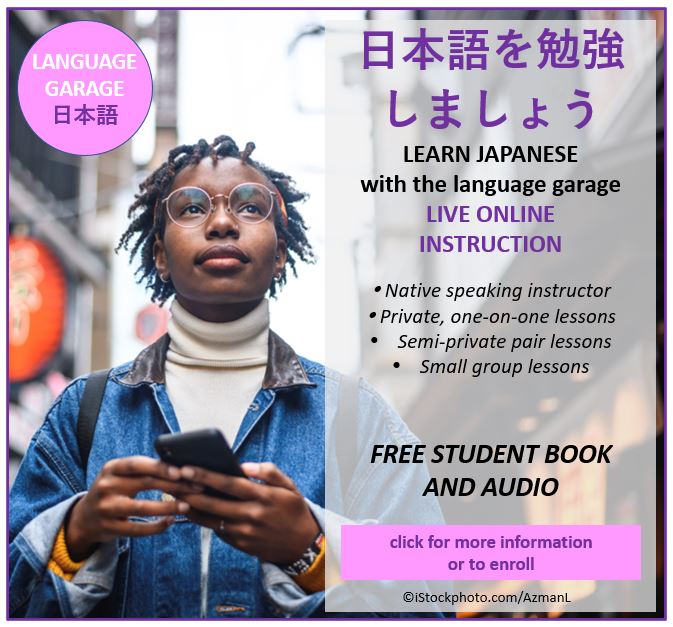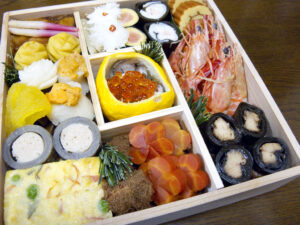This post about how to say and in Japanese is brought to you by Mamori Sugita, who teaches Japanese. Meet her and our other fantastic instructors here.
There are Multiple Ways to Say AND in Japanese
Saying “and” is a little tricky in Japanese because it is expressed in different ways depending on what comes before and after it. In this post, we will go over different types of “___ and ___” phrases and sentences and we’ll show you how to say “and” in Japanese in each of the cases. You will be an expert of “and” in Japanese by the time you finish reading!
Connecting Two Nouns with と to
If a noun comes before and after “and,” use the particle と to to connect them. For example:
- りんご と バナナ
ringo to banana
apple(s) and banana(s)
Both りんご ringo and バナナ banana are nouns, so you can use the particle とto to connect them. This sounds simple and easy, but the problem is that it’s not uncommon for learners to start using the particle とto whenever they want to say “and”, including when connecting things other than nouns. For example:
かわいい と おもしろい←wrong!kawaī to omoshiroi←wrong!
cute and funny ←intended meaning
The above phrase is wrong. What’s wrong with it? Both かわいい kawaī and おもしろい omoshiroi are adjectives. You cannot use the particle と to to connect adjectives. You can use the particle とto only when you connect nouns.
We’ll come back to connecting two adjectives (and more) in a moment, but let’s first see some more examples of とto connecting nouns. Notice that you attach whatever particle is necessary to the entire noun phrase when you’re using this construction in a sentence. If we take the first example below, you attach the object-marking particle を o to the entire noun phrase ごはんととうふ gohan to tofu rice and tofu.
- ごはん と とうふ を たべて います。
Gohan to tōfu o tabete imasu.
I’m eating rice and tofu. - あにと あね が います。
Ani to ane ga imasu.
I have a big brother and a big sister. - ねこ と いぬ が います。
Neko to inu ga imasu.
I have a cat and a dog. - シャツ と セーター を かいました。
Shatsu to sētā o kaimashita.
I bought a shirt and a sweater. - バニラ と チョコレート は おいしいです。
Banira to chokorēto wa oishīdesu.
Vanilla and chocolate are delicious. - パスタ と サラダ を たべました。
Pasuta to sarada o tabemashita.
I ate pasta and salad.
Connecting Sentences with それからsorekara or そして soshite
If you want to connect two sentences instead of two nouns, you can use either それから sorekara or そして soshite. Both conjunctions are fine, but それから sorekara sounds colloquial, while そして soshite sounds a bit formal. Let’s look at some examples where two sentences are connected by それから/そして sorekara/soshite:
- きのう かいもの を しました。 それから えいがを みました。
Kinō kaimono o shimashita. Sorekara ēga o mimashita.
Yesterday, I went shopping. And I watched a movie. - ばんごはん を たべました。 それから ほん を よみました。
Bangohan o tabemashita. Sorekara hon o yomimashita.
I ate dinner. And I read a book. - けさ へや を そうじしました。 そして ジム に いきました。
Kesa heya o sōji shimashita. Soshite jimu ni ikimashita.
This morning I cleaned my apartment. And I went to the gym. - あに は だいがくを そつぎょうしました。 そして ニューヨーク に ひっこしました。
Ani wa daigaku o sotsugyō shimashita. Soshite nyūyōku ni hikkoshimashita.
My big brother graduated from college. And he moved to New York.
You may find the English translation a little awkward, and you may find it simpler and more natural to say things like I went shopping and watched a movie or I ate dinner and read a book. We’ll come back to connecting two verb phrases instead of sentences like that in a moment. This construction is easier, and it’s actually perfectly natural sounding in Japanese, so don’t worry!
By the way, you may also hesitate to start a sentence with “and” in English, but in fact, the Japanese expressions それから sorekara and そして soshite must be placed at the beginning of a sentence.
Connecting Adjectives with て -te
To connect adjectives, you need to use the て -te form. This is advanced-beginner (or JPNS 102) level grammar, but if you’re not familiar with it, don’t worry, it’s not terribly difficult. It’s just different from what you’re used to doing in English. Here’s an example:
- ラーメン は やすくて おいしい です。
Ramen wa yasukute oishī desu.
Ramen is cheap and delicious.
Instead of using a single word that corresponds to “and”, we use the て -te form of the first adjective やすい yasui cheap, which is やすくてyasukute. So basically, やすくて yasukute in this example corresponds to “cheap and…” in English. Let’s see a few more examples of て -te forms of adjectives adding the meaning “and” to a sentence.
- ゆきさん は おもしろくて あたまが いい です。
Yuki-san wa omoshirokute atama ga ī desu.
Yuki is funny and smart. - けんじさん は せ が たかくて かっこいい です。
Kenji-san wa se ga takakute kakkoī desu.
Kenji is tall and good-looking. - とうきょう は おおきくて にぎやか です。
Tōkyō wa ōkikute nigiyaka desu.
Tokyo is big and busy.
If you want to use three adjectives in one sentence, use the て -te form for the first two adjectives:
- ラーメンは やすくて おいしくて かんたん です。
Ramen wa yasukute oishikute kantan desu.
Ramen is cheap, delicious, and easy. - ゆきさん は やさしくて おもしろくて あたま が いい です。
Yuki-san wa yasashikute omoshirokute atama ga ī desu.
Yuki is kind, funny, and smart.
Connecting Verbs with て -te
You use the same て -te form to connect verbs. Take a look:
- きのう テレビ を みて ねました。
Kinō terebi o mite nemashita.
Yesterday, I watched TV and went to bed.
Just like adjectives, verbs have て -te forms that you use whenever the verb (phrase) is connected to another verb (phrase). In the above example, we have to use the て -te form of the verb みます mimasu, which is みて mite. So basically, テレビをみて terebi o mite corresponds to “watched TV and...”
When using the て -te form, you don’t have to worry about tense. The て -te form is tenseless, meaning there is no such thing as present tense て -te form or past tense て -te form. The time of the action denoted by the て -te form verb is determined by the tense of the final verb in the sentence. In the above example, the final verb is ねました nemashita, which is a past tense form. So, the TV watching activity is also understood to have happened in the past.
- ばんごはん を たべて しょっき を あらいました。
Bangohan o tabete shokki o araimashita.
I ate dinner and did the dishes. - でんき を けして ねました。
Denki o keshite nemashita.
I turned off the light and went to sleep. - シャワー を あびて ふく を きました。
Shawā o abite fuku o kimashita.
I took a shower and got dressed.
Let’s look at another example. This time, there are three verbs and the sentence refers to future time.
- あした ろくじ に おきて あさごはん を たべて かいしゃ に いきます。
Ashita rokuji ni okite asagohan o tabete kaisha ni ikimasu.
Tomorrow, I’ll get up at six, eat breakfast, and go to work.
Since three verbs are used in this sentence, you use the て -te form for the first two; i.e. おきて okite and たべて tabete. The tense of the final verb is non-past. In fact, the sentence begins with あした ashita tomorrow, so we understand that all activities mentioned in the sentence are going to happen in future, tomorrow to be exact.
Connecting Gerunds with と to
We said earlier that the particle とto can only connect nouns, but this also means that you can connect gerunds, which are nouns derived from a verb. Examples of English gerunds are swimming and running as in: Swimming is fun and I enjoy running every morning. In Japanese, you can make a gerund by marking a plain form verb with the particle の no. So, swimming is およぐの oyoguno, and running is はしるの hashiruno. Let’s connect those two gerunds in a sentence:
- およぐの と はしるの が すきです。
Oyoguno to hashiruno ga suki desu.
I like swimming and running. - およぐの と はしるの は たのしいです。
Oyoguno to hashiruno wa tanoshī desu.
Swimming and running are fun.
A, B, and C: How to Connect More than Two Nouns
When connecting more than two nouns in English, we only use “and” once at the end of the list, such as in I saw Tom, Paul, and Mary at the party. How about in Japanese? In fact, the way Japanese lists nouns is quite different from English.
When speaking informally, you can use the particle とto after every noun except for the final one,as in:
- トムさん と ポールさん と メアリーさん に あいました。
Tomu-san to Pōru-san to Mearī-san ni aimashita.
I saw Tom, Paul, and Mary.
Since there are three nouns in the above example, you use the particle とto twice. If there are four nouns, you use the particle とto three times.
But if you are using formal language (especially in formal writing), do not use the particle とto at all. Here’s an example:
- わたしは ちゅうごく、かんこく、タイ、ベトナム へ いった。
Watashi wa Chūgoku, Kankoku, Tai, Betonamu e itta.
I went to China, Korea, Thailand, and Vietnam.
As you can see, there is no particle とto in the above example. You only use commas in formal writing; and if you are speaking, just take a pause between the nouns.
Optionally, you could use そして soshite right before the last item when you are using formal language like the following:
- わたしは ちゅうごく、かんこく、タイ、そして ベトナム へ いった。
Watashi wa Chūgoku, Kankoku, Tai, soshite Betonamu e itta.
I went to China, Korea, Thailand, and Vietnam.
This looks sort of similar to the English style of “A, B, and C”, but it’s important to remember that the particle と to can never be used here; it has to be そしてsoshite. (それから sorekara is fine too but since we are assuming formal language here, the formal-soundingそしてsoshite fits better.)
To Summarize
The English conjunction “and” corresponds to multiple expressions in Japanese depending on what you are trying to connect.
- When connecting nouns (including gerunds), use the particle とto.
- When connecting adjectives or verbs, use the て -te form.
- When connecting sentences, use それからsorekara or そして soshite.
- When listing more than two nouns, use the particle とto after every noun (except for the final one) in an informal setting, but don’t use the particle とto at all in a formal setting (especially in formal writing).
Get on the road to speaking Japanese with the Language Garage!
We hope you’ve enjoyed learning how to say and in Japanese. If you’d like to learn more:
- Create a free Language Garage account to access tons of Japanese vocabulary, grammar, and culture.
- Follow us on Facebook, LinkedIn, BlueSky, Twitter, Threads, Mastodon, Instagram, or Pinterest. We publish lots of Japanese vocabulary, grammar, and culture notes, so it’s a great way to pick up some new vocabulary and practice.
- Check out our other posts on Japanese language, culture, and more.
- Enroll in affordable, flexible, and personalized private online Japanese lessons or sign up for a small group online Japanese class.
Image Source: StockSnap on Pixabay






